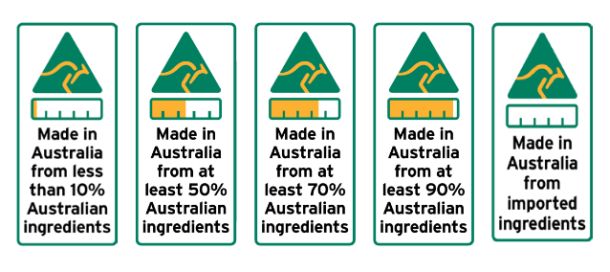
The new Country of Origin Labelling (CoOL) for Australia's food packaging was given the final go-ahead by commonwealth, state and territory consumer affairs ministers this week.
Each label will indicate the proportion of Australian ingredients by weight, displayed in a statement and a bar graph that aims to be easier for consumers to read.
The new CoOL will include a statement about where the food was produced, grown, made or packaged.
Most food products will also carry the familiar kangaroo symbol and an indication of the proportion of Australian ingredients by weight through a statement and a bar graph.
The new system will also see clearer rules around when food labels can carry ‘made in’ or ‘packed in’ statements.

The reforms will start from 1 July this year, and business will have two years to transition to the new arrangements.
In addition, current stock in trade will also be allowed to see out its use-by-date.
According to the government, there is still work to be done to finalise the reforms before they can officially commence, including registration, tabling and passing of changes to Australian Consumer Law (ACL) legislation including the new Information Standard and amendments to the ACL safe harbour defences.
The government also plans to publish an online tool, Style Guide, and other resources to assist businesses to determine which labels to use, and to download label artwork.
A national information campaign to inform consumers and business about the reforms will also be undertaken.
Vegetable industry body Ausveg welcomed the news.
“After many years of campaigning for effective reforms that eliminate ambiguous and deceptive labelling terminology, Ausveg is pleased that the state departments have maximised the opportunity to come together and support the Federal Government’s proposed reforms,” said CEO Richard Mulcahy.
“Although the proposed system does not offer a complete solution to these issues, AUSVEG recognises that it is an encouraging step forward to provide consumers with more transparent, informative labelling on the foods they buy.”
The Australian Made Campaign, the not-for-profit organisation that administers and promotes Australia’s green-and-gold ‘Australian Made, Australian Grown’ logo, also welcomed the new label.
“More transparent food labelling will give shoppers a better understanding of the provenance of their purchases and provide Australian farmers and manufacturers with a much-needed leg up,” Chief Executive Ian Harrison said.
“Furthermore, widespread use of a symbol incorporating the Australian Made, Australian Grown logo should further boost the logo's strong connection to Australia, and with that, the sales of great Aussie goods in domestic and global marketplaces.”
The kangaroo logo and bar chart will only apply to priority foods.
Consumers won’t see new country of origin labels on non-priority foods such as biscuit and snack foods, bottled water, tea, coffee and alcoholic beverages.
“Unfortunately, the new system looks less useful for consumers wanting information about any of the 195 countries that are not Australia," CHOICE spokesperson Tom Godfrey said.
"For example, claims such as ‘Made in Australia from imported ingredients’ will still have you wondering where your food comes from.”





